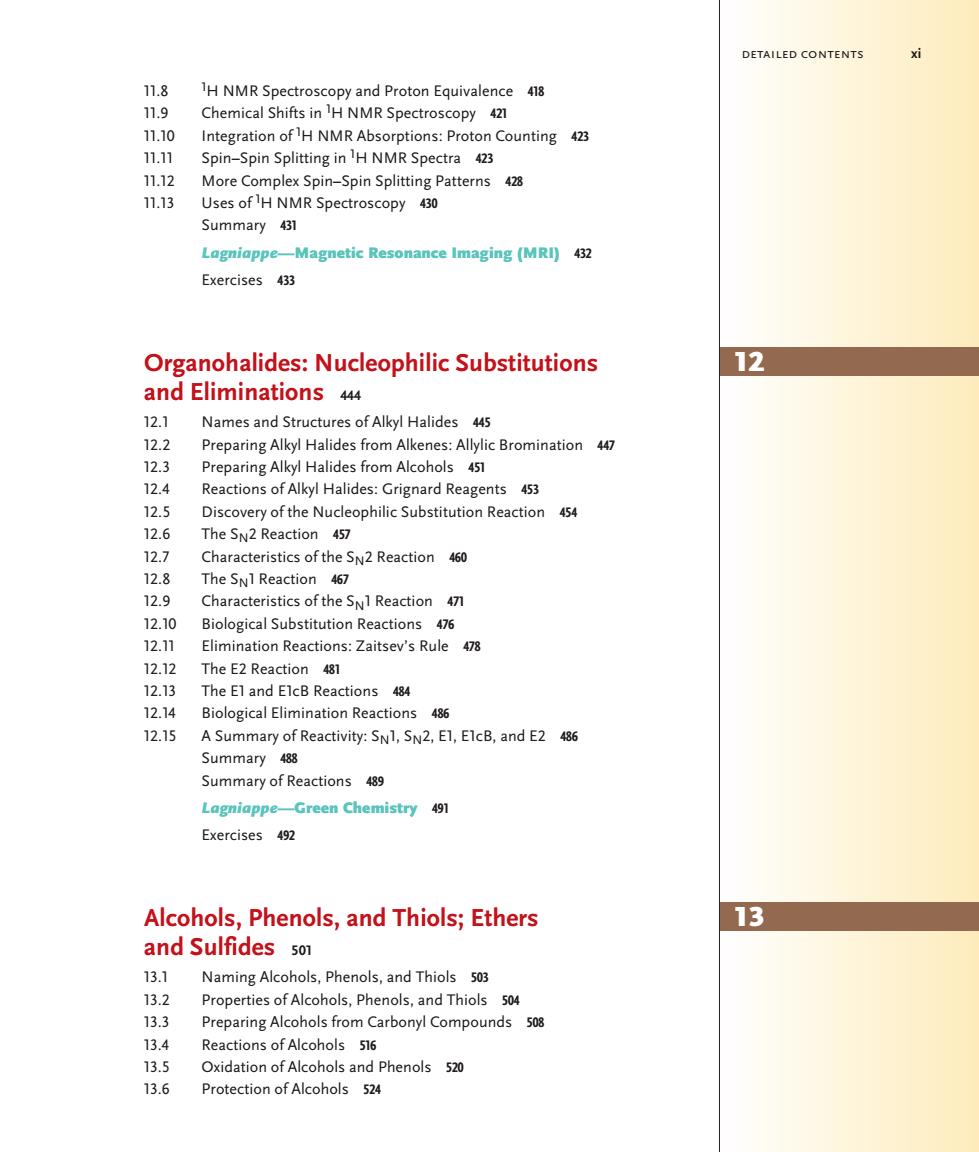正在加载图片...

DETAILED CONTENTS 切 8 H NMR Spectroscopy and Proton Equivalence 418 11.9 Chemical Shifts in H NMR Spectroscopy 421 11.10 Integration of H NMR Absorptions:Proton Counting 423 Spin-Spin Spliting inHNMR Spectra 11.12 More Complex Spin-Spin Splitting Patterns 428 11.13 Uses of 1H NMR Spectroscopy 430 Summary 431 Lagniappe-Magnetic Resonance Imaging(MRI)432 Exercises 433 Organohalides:Nucleophilic Substitutions 12 and Eliminations 444 12.1 Names and Structures of Alkyl Halides 445 12.2 Preparing Alkyl Halides from Alkenes:Allylic Bromination 447 12.3 Preparing Alkyl Halides from Alcohols 451 12.4 Reactions of Alkyl Halides:Grignard Reagents 453 12.5 Discovery of the Nucleophilic Substitution Reaction 454 12.6 The SN2 Reaction 457 12.7 Characteristics of the SN2 Reaction 460 12.8 12.9 The SNI Reaction 467 Characteristics of the SNI Reaction 47 12.10 Biological Substitution Reactions 476 12.11 Elimination Reactions:Zaitsev's Rule 478 12.12 The E2 Reaction 12.13 The El and ElcB Reactions 484 12.14 Biological Elimination Reactions 486 12.15 A Summary of Reactivity:SN1,SN2,E1,EIcB,and E24 Summary488 Summary of Reactions 489 Lagniappe-Green Chemistry 491 Exercises 492 Alcohols,Phenols,and Thiols;Ethers 13 and Sulfides so 13.1 Naming Alcohols,Phenols,and Thiols 503 132 Properties of Alcohols,Phenols,and Thiols 504 13.3 Carbony Compounds 13.4 Reactions of Alcohols 516 13.5 Oxidation of Alcohols and Phenols 520 13.6 Protection of Alcohols 524detailed contents xi 11.8 1 H NMR Spectroscopy and Proton Equivalence 418 11.9 Chemical Shifts in 1 H NMR Spectroscopy 421 11.10 Integration of 1 H NMR Absorptions: Proton Counting 423 11.11 Spin–Spin Splitting in 1 H NMR Spectra 423 11.12 More Complex Spin–Spin Splitting Patterns 428 11.13 Uses of 1 H NMR Spectroscopy 430 Summary 431 Lagniappe—Magnetic Resonance Imaging (MRI) 432 Exercises 433 Organohalides: Nucleophilic Substitutions and Eliminations 444 12.1 Names and Structures of Alkyl Halides 445 12.2 Preparing Alkyl Halides from Alkenes: Allylic Bromination 447 12.3 Preparing Alkyl Halides from Alcohols 451 12.4 Reactions of Alkyl Halides: Grignard Reagents 453 12.5 Discovery of the Nucleophilic Substitution Reaction 454 12.6 The SN2 Reaction 457 12.7 Characteristics of the SN2 Reaction 460 12.8 The SN1 Reaction 467 12.9 Characteristics of the SN1 Reaction 471 12.10 Biological Substitution Reactions 476 12.11 Elimination Reactions: Zaitsev’s Rule 478 12.12 The E2 Reaction 481 12.13 The E1 and E1cB Reactions 484 12.14 Biological Elimination Reactions 486 12.15 A Summary of Reactivity: SN1, SN2, E1, E1cB, and E2 486 Summary 488 Summary of Reactions 489 Lagniappe—Green Chemistry 491 Exercises 492 Alcohols, Phenols, and Thiols; Ethers and Sulfides 501 13.1 Naming Alcohols, Phenols, and Thiols 503 13.2 Properties of Alcohols, Phenols, and Thiols 504 13.3 Preparing Alcohols from Carbonyl Compounds 508 13.4 Reactions of Alcohols 516 13.5 Oxidation of Alcohols and Phenols 520 13.6 Protection of Alcohols 524 12 13 39144_ FM_i-xxiv.indd xi 8/26/09 10:48:50 AM